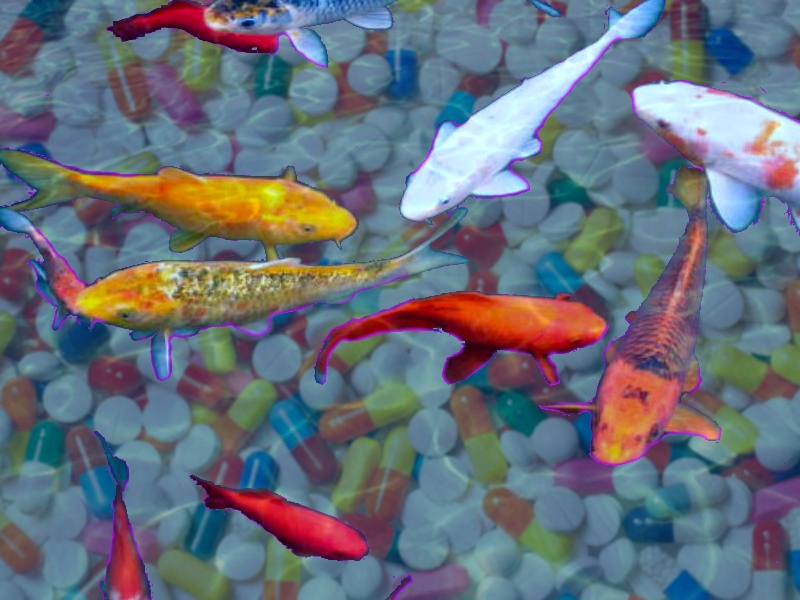|
By Uma Chandrasekaran
Long gone are the days of saying that an “apple a day keeps the doctor away”. Modern day science has transformed our lives. They have made us believe, “pill a day keeps the disease at bay”. Not just drugs, but our day-to-day existence is unimaginable without a myriad of personal care products (PPCPs) like antibacterials, antiperspirants and sunscreen. Turns out, these pharmaceutical drugs and personal care products, in addition to adorning our household cabinets, also spill out into our waterways. Their journey does not end there. This uncanny mixture of assorted chemicals finds its way to our rivers only to turn them into a “chemical soup.” According to a recent study [1], a total of 93 pharmaceuticals (concentration range:0.35-15,000 ng/L) ranging from caffeine to prescription drugs (antibiotics, anti-depressants and contraceptives) to disinfectants contaminate the surface waters of the USA.
Aquatic ecologists like, Dr. Emma Rosi-Marshall at the Cary Institute in New York, study the environmental impact of these novel contaminants (PPCPs), that are polluting our nation's rivers and streams (consequence of the chemical soup!).
In a recent talk at the Cary Institute [2,3], Dr. Rosi-Marshall addressed two important questions: How PPCPs get into our rivers and streams and what are the impacts on the aquatic ecosystem? She points out that both unused drugs from human body and chemical effluents from manufacturing factories/laboratories end up in wastewater treatment plants. Since our wastewater treatment plants are not equipped to remove pharmaceutical contaminants, our rivers and streams end up hosting pharmaceutical wastes [4]. The result is, our tap water may not be just H2O, but rather a chemical concoction. Up until recently, the regulatory agencies had us believe that there were no adverse consequences due to trace of pharmaceuticals in our water sources, but emerging studies from Dr. Rosi-Marshall’s lab suggest that even trace (ng/L) concentrations of these drugs can suppress algal growth by 50-90%. When her team exposed bacteria grown in artificial river streams to Triclosan - a common antimicrobial found in a variety of consumer products like soaps and shampoos, in the concentration range detected in surface waters, they found that the bacterial growth was not affected as they became resistant to the antimicrobial. Also, Triclosan promoted communities of Triclosan-resistant bacteria thereby altering the composition of the bacterial communities. After careful investigations, Dr.Rosi-Marshall suggests that the effect of various pharmaceuticals on bacterial life is not the same and it varies with the individual compound. Her research team further assessed the effect of drugs on aquatic insects and found that some species of insects grew larger in the presence of antidepressants such as Prozac. A point to note is that the above-mentioned studies assessed the effect of individual drugs on riverine organisms. However, the combined effect of the cocktail of drugs found in our waters, on the aquatic ecosystem has not been investigated yet. “We have just begun to scratch the surface of figuring out how the chemicals are affecting our aquatic ecosystem” said Dr. Rosi-Marshall at the end of her talk. Her research focus also includes understanding the ripple effect of PPCP contamination on the aquatic food chain. While advancement in science has immensely contributed towards our modern day fetish for instant gratification and comfort, it has also unleashed a chemical Armageddon of sorts on the aquatic ecosystem. There are ways in which we can contain the chemical spew. We can be more judicious in the use of drugs and personal care products. In case you are wondering how - do we really need those hand sanitizers when soap and water is readily available and why take vitamin supplements when fruits and vegetables are in surplus? We can make use of the government sponsored drug take-back programs and safely dispose of unused drugs through incineration. Also, the real issue with these chemicals is that, since they are synthetic creations of mankind they have no counterparts in nature and are non-biodegradable. A simple solution to this conundrum would be to increase the use of biodegradable/ organic products whenever possible, through creating widespread awareness on the existence of organic options. Of course, maintaining and upgrading our wastewater plants with advanced technologies capable of removing pharmaceutical contaminants would be ideal. Overall, we should all remember what Robert Green Ingersoll once said “In nature, there are neither rewards nor punishments; there are consequences.” ---------- Sources: 1.http://www.researchgate.net/publication/262572945_Pharmaceuticals_in_the_Surface_Water_of_the_USA_A_Review 2. http://www.caryinstitute.org/events/lecture-videos/our-rivers-drugs. 3. http://www.caryinstitute.org/newsroom/our-river-drugs 4. http://www.epa.gov/ppcp/pdf/drawing.pdf
Comments? Leave them below! |
Archives
February 2023
DiscovHER BlogScientista DiscovHER is a blog dedicated to discovHERies made by women in science. Follow us for links to the latest resHERch! Categories
All Alexandra Brumberg Amy Chan Avneet Soin Chemistry Diana Crow Engineering Health/medicine Indulekha Karunakaran Iqra Naveed Johanna Weker Lidiya Angelova Michael Clausen Mind Brain And Behavior Muhammad Hamza Waseem Nikarika Vattikonda Opinion Prishita Maheshwari-Aplin Technology Uma Chandrasekaran |
The Network for Pre-Professional Women in Science and Engineering
The Scientista Foundation is a registered 501(c)(3) -- Donate!



 RSS Feed
RSS Feed